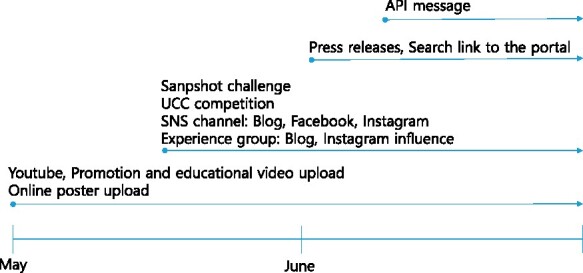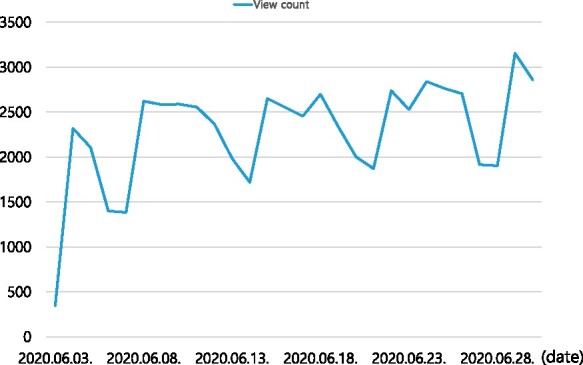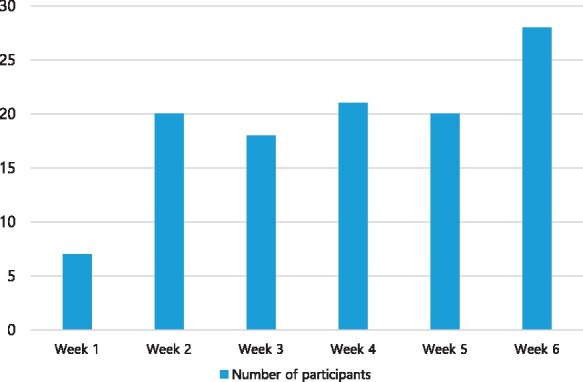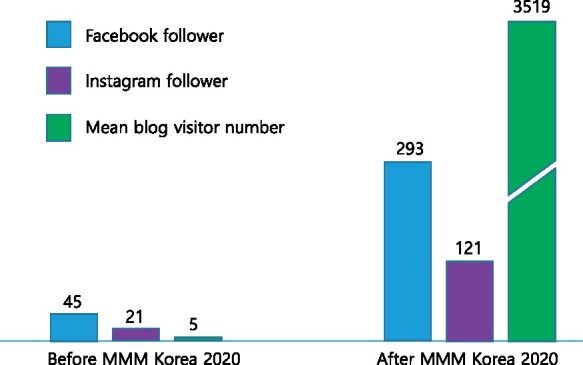Abstract
Aims
May Measurement Month (MMM) is a global campaign to enhance hypertension awareness by intensive blood pressure measuring campaign during a month period of May. May Measurement Month 2020 was not officially executed globally, especially in light of COVID-19 pandemic. But in Korea, the MMM committee decided to carry on with self-initiated project to succeed MMM started in 2019 in Korea. And we adopted new online strategies for those with age of 18 or older under the MMM
Methods and results
Korea 2020 theme in Korean of ‘Look for the Young Hypertension’. A promotional video, a subtitled translated global promotional video, and four educational contents were uploaded on Youtube®. Seven online posters or card news were uploaded on main blog. And 71 articles by 60 websites from 10 medical media company were published. The MMM keyword exposure in Naver® portal Search Advertisements was 2500 searches per day. There were 3519 visits to the MMM blog, and 114 people participated in snapshot challenges. Four social network service channels were activated, and there was an increase in Facebook and Instagram followers of 6.5- and 5.8-fold, respectively. GoodDoc® application programming interface messages were sent 97876 times (2589 responses). For a user created contents contest, 28 competitors, mostly young, participated.
Conclusion
Even during the COVID-19 pandemic, the MMM campaign was able to survive using a ‘new normal’ online format. The shift to on-line activity during the pandemic will contribute to a breakthrough MMM campaign in the future that can be combined with off-line protocols even after the pandemic.
Keywords: Awareness, Hypertension, Blood pressure measurement, COVID-19, Public health, On-line campaign
Introduction
Rates of raised blood pressure have been increasing and high systolic blood pressure is the leading risk factor accounting for 10.4 million deaths and 218 million Disability adjusted life years globally.1,2 Diastolic blood pressure is more important in the younger adult or children than the elderly. There has been a recent increase in hypertension in Asian countries owing to Westernization, modernization, urbanization, and a poor control rate, which has become a major public health challenge.3 Awareness of hypertension varies widely, even in developed countries from 40% to 80%.4 In Asian countries, the awareness rate ranges more widely from 20% to 60%.5 Needless to say, increasing awareness is the first step to improve overall hypertension management. To achieve this goal, the May Measurement Month (MMM) global campaign was launched in 2017.6
May Measurement Month in Korea (MMM Korea) was launched in 2019 under the support of global MMM headquarters. MMM Korea established five fundamental strategies: (i) support by the Korean Society of Hypertension (KSH) to establish the theme of the campaign each year, (ii) Endorsement by government agencies such as the Korea Disease Control and Prevention Agency (KDCA) and Korean National Health Insurance Service (NHIS), (iii) Nationwide collaboration with community health centres, (iv) collaboration with large city governments, and (v) adaptation to local culture. In South Korea, May is the month for the family. Therefore, the concept of MMM Korea is ‘to measure BP in May for the health of you and your family’.
MMM Korea in 2020 was planned under the theme of ‘Look for the Young Hypertension’. In South Korea, awareness of hypertension was 65% in 2016. In particular, awareness among those in their 30s and 40s was 19.8% and 44.8%, respectively, and was much lower than the older population.7
In 2020, MMM Korea suddenly faced the COVID-19 pandemic, which precluded any type of face to face or off-line gathering since February and a serious outbreak made the guidelines more strict. Therefore, the committee revised the entire format of MMM Korea 2020 into a ‘new normal’ online campaign because the younger target population according to the theme would be more likely to respond to a new type of online campaign.
Herein, we report the protocol and the results of the MMM Korea 2020 campaign using this new format instead of cancelation under COVID-19 pandemic.
Methods
Planning for MMM Korea 2020
The MMM steering committee was established as a separate group in the KSH comprising the council member of the ISH as the chairman, the secretary general of the KSH, the director of the scientific committee of the KSH, the director of the advertisement committee of the KSH, and the director of International Liaison. A budget was supplied by the KSH and three industrial sponsors. Governmental collaboration was acquired from the section for non-communicable diseases in the KDCA and NHIS. Local governmental collaboration with Daegu Metropolitan City had been planned but it was on hold because of COVID-19. The theme of MMM Korea 2020 was ‘Look for the Young Hypertension’ before COVID-19, and it was maintained because this theme was suitable for the campaign in the new normal online format. A scientific collaboration with the Korean Circulation Society was also prepared.
The purpose of the on-line contents was to provide reference information about the importance of getting blood pressure measurement and the control of high blood pressure because misinformation videos about hypertension were spreading online. The rationale for the experiences, such as the snapshot challenge and participation programmes such as user created content (UCC), was based on experiential learning and project-based learning, respectively.8,9 A social network service (SNS) platform was chosen to provide the contents in a format that is more friendly to mobile phones and to younger generations. A professional advertisement company was employed for the administration of an on-line specific campaign.
Protocol for the MMM Korea 2020 online format
MMM in Korea (MMM Korea) was launched in 2019 under the support of global MMM headquarters according to the protocol applied global MMM.10 But in 2020, original MMM protocol could not be performed because of COVID-19 pandemic. First of all, because all personal contact in public was banned, in MMM Korea 2020, standard offline activities, such as collection of BP levels and questionnaire for participants could not be allowed. Only on-line activities were adopted. Table 1 shows the campaign programme for MMM Korea 2020. YouTube contents for promotion and education was uploaded by collaborating institutes, the KSH promotional ambassador (a radio entertainer), and the steering committee members. Internet contents, such as portal search advertisements, on-line posters or card news, a dedicated blog site for MMM Korea, and press releases for on-line medical media were created. A portal search was linked to a press release and other online contents. In the SNS campaign, snap shot challenges for self BP measurement, influencer experience group activities, and a running SNS channel for MMM Korea 2020 were carried out with incentives, such as gifticons. ‘Gifticon’ is a new convergence service item developed by the Korean company, by giving or receiving it, to enable one to send a real present to others using instant messenger or mobile data service. For the snapshot challenge was defined as taking a snapshot of the self-blood pressure measurement for oneself and uploading it on three MMM Korea 2020 SNS, i.e. Facebook® (https://url.kr/4VkPqg), Instagram® (https://www.instagram.com/p/CCFLdgWh4Bv/?utm_source=ig_web_copy_link), or the MMM Korea 2020 blog in Naver®, the most representative portal site in Korea (https://blog.naver.com/mmm_2020). Required hashtag was, at least, any one among ‘#KSH (in Korean), #MayisthemonthtomeasureBP (in Korean), #younghypertension (in Korean), #BPmeasurement (in Korean), #Hypertension (in Korean), #MMM, #K_MMM20 #maymeasure, and #checkyourpressure’. API (application programming interface) messages for MMM via the currently established medical service applications for patients, GoodDoc®, was delivered two times with a week interval. GoodDoc® is one of the most popular healthcare mobile application in Korea. And API was composed of promotion to participate in on-line activity directly by clicking, which activates the main blog of MMM Korea 2020 (https://blog.naver.com/mmm_2020) with redirection to the snapshot challenge with first API message and to the UCC page. For the participating programme, a UCC competition was started. The theme of the 30–60 s length video contents was supposed to be created and uploaded according to one of the following topics: ‘What is MMM?’, ‘Importance of BP control’, ‘Importance of BP measurement’, ‘Awareness in the young’, and ‘Risk of hypertension’. The KDCA Director Award, the KNHIC Chairman Award, the KSH president Award, the KSC president Award, and three MMM director Awards were conferred. All of the programmes spanned over 8 weeks during May and June (Figure 1).
Table 1.
Overview of the May Measurement Month programme in 2020 in Korea
| Category | Subcategory |
|---|---|
| YouTube contents | |
| Promotional | |
| Educational | |
| Internet promotion | |
| Portal SA | |
| On-line poster or card news | |
| Blog for MMM Korea | |
| Press releases | |
| SNS campaign | |
| Snapshot challenge | |
| Influencer experience groups | |
| Opening SNS channel | |
| API messaging | |
| Use created contents competition |
API, application programming interface; MMM, May Measurement Month; SA, search advertisement; SNS, social network service.
Figure 1.

The ‘new normal,’ online programmes for May Measurement Month Korea 2020 spanning over a 2-month period according to the preparedness of each programme. API, application programme interface; SNS, social network service; UCC, user created contents.
Results
Youtube video contents
A promotional video for MMM Korea 2020 was made by a collaboration among the director of MMM Korea 2020, the director of KDCA, a radio entertainer, and the president of KSH (https://www.youtube.com/watch?v=S0IzEFffVdw), and one subtitle translated promotional video (https://www.youtube.com/watch?v=81RWkXXWKHE&t=3s) produced by Servier for a supporting campaign called BISS, which means ‘Because I Say So’ was uploaded. Four dialogue-based educational contents [(i) let’s measure BP in May, the month of the family (https://www.youtube.com/watch?v=nIAtIofuV9A&t=11s), (ii) look for young hypertension (https://www.youtube.com/watch?v=FBfnfzs1IeY&t=2s), (iii) how to measure blood pressure (https://www.youtube.com/watch?v=S5rMhf-wde4&t=1s), and (iv) how to treat hypertension (https://www.youtube.com/watch?v=ZxXbClqYTYo&t=74s)] were also uploaded.
Internet campaign
Seven online posters or card news, the links for the above-mentioned video contents were uploaded on the MMM blog(https://blog.naver.com/mmm_2020), and 71 articles on 60 websites by 10 domestic medical media organizations were published. MMM keyword exposure in the Naver portal search advertisement was about 2500 per day on average and visits to the blog totalled 3519 (Figure 2).
Figure 2.

The trend of the view count of the contents for May Measurement Month Korea 2020 in the main portal website in Korea.
Social network service activities
People with age of 18 or older (n = 114) including SNS influencers participated in the snapshot challenges and 20 gifticons for coffee or snacks per weeks for 6 weeks were delivered through a lottery. As shown in Figure 3, the participant numbers increased but plateaued or converged to the number of gifticons offered. Four SNS channels were activated and maintained: Naver blog (https://blog.naver.com/mmm_2020), Facebook (https://url.kr/4VkPqg), Youtube (https://www.youtube.com/channel/UCBW9gtsJ4afAG3bK_Je3tuw/videos), and Instagram (https://www.instagram.com/p/CCFLdgWh4Bv/?utm_source=ig_web_copy_link). The Increase in Facebook and Instagram followers was 6.5- and 5.8-fold, respectively (Figure 4).
Figure 3.

The trend of the number of participants in the snapshot challenge for self-measurement of blood pressure during the May Measurement Month Korea 2020 campaign.
Figure 4.

Increase in followers before and after the May Measurement Month Korea 2020 campaign.
Messaging using the application programming interface
At times when the open rate was highest, i.e. at 8:30 am on Friday, API messages were sent two times (12th and 19th June). A total of 97 876 API messages were delivered through Kakaotalk® alarm, and there were 2589 responses during the campaign. As shown in Table 2, the click through rate was the highest in 41–50 aged group but it was still not so low in the younger aged groups.
Table 2.
Application programming interface messaging for the May Measurement Month campaign in 2020 in Korea
| Age of the participants |
|||||
|---|---|---|---|---|---|
| 20–25 | 26–30 | 31–40 | 41–50 | Total | |
| Message sent | 13 350 | 11 498 | 36 519 | 36 509 | 97 876 |
| Message opened | 7003 | 7403 | 27 232 | 28 726 | 70 364 |
| Open rate | 52.46% | 64.39% | 74.57% | 78.68% | |
| Click for the event | 226 | 239 | 994 | 1227 | 2686 |
| CTR (click/sent) | 1.69% | 2.08% | 2.58% | 3.36% | |
| CTR (click/open) | 3.23% | 3.23% | 3.47% | 4.27% | |
| CTR, click through rate | |||||
User created content competition
A total of 28 competitors participated. As shown in Table 3, a majority of the competitors were between the ages of 20 and 40 years. Most common themes among those created contents were awareness in the young as shown in Table 3.
Table 3.
Distribution of the age of the competitor and the topic included in the user created contents
| Numbers | |
|---|---|
| Age | |
| <20 | 4 |
| 21–30 | 13 |
| 31–40 | 5 |
| 41–50 | 4 |
| 51–60 | 2 |
| Subjects in the UCCa | |
| What is MMM ? | 1 |
| Importance of BP control | 5 |
| Importance of BP measurement | 8 |
| Awareness in the young | 13 |
| Risk of hypertension. | 11 |
| Others | 2 |
Possibly multiple in a UCC.
Discussion
The COVID-19 pandemic was an unexpected challenge to the MMM field campaign. This crisis is said to be protracted for at least 2 years. Adopting a ‘crisis into opportunity’ strategy, MMM Korea 2020 tried a comprehensive on-line campaign for the first time. Because it took extra time to establish the programme and protocols, it was extended to the end of June. The results were successful in the online format and will be continued in addition to the conventional campaign, which will be resumed when COVID-19 subsides. As shown in our report, MMM 2020 Korea seems to be effective, in particular, for younger generations who are accustomed to SNS or mobile applications. Interestingly, younger generations also responded to API messaging using healthcare applications in three quarters of the older generation (Table 2). Because the application is basically developed for patients who visit a hospital, the response of the younger generation has two implications. First, relatively more younger patients could install and use the application than older ones. Second, younger family members might have installed the application to help older family members or patients.
Evolution and succession of MMM Korea 2019
Because the programme and protocols used in MMM Korea 2020 were not exclusive but complimentary to the previous MMM Korea programme, it could be continued. For next year’s MMM Korea, preparedness for the on-line programme and protocol seems to be an important factor to carry out concentrated and intensive activities during the campaign period. Second, to take maximum advantages of SNS, more aggressive or intensive approaches, such as large scale outsourcing concentrated during the campaign could be considered.
But there were significant difference or limitations in the online campaign specifically in terms of the originality of global MMM campaign. As shown in Table 3 and some online education media, MMM Korea 2020 was not totally dedicated to the importance of BP measurement because other aspect of hypertension managements was included. It could be a compromise for successful trial of the first online campaign and it has to be improved to focus on the importance of BP measurement.
Interest in young hypertension
In a recent meta-analysis, hypertension prevalence was reported to have increased in younger populations along with risk associated with high blood pressure.11 In South Korea, awareness in those aged 30–49 years was 35.8%. A clinic visit followed by awareness is an important factor for better hypertension management.12 This means that educational approaches meticulously designed by motivational strategies may be useful. In this respect, MMM Korea 2020, as shown by the theme of ‘Look for young hypertension’ has implications concerning the usefulness of an on-line format MMM for younger populations. Whether the current on-line or SNS environment is helpful or harmful in terms of the quality of information about hypertension and other chronic conditions needs attention because of the possibility of misinformation regarding high blood pressure by many on-line contents driven by economical or commercial interests. In this respect, activities to improve the overall quality of information about hypertension should be continuously maintained through collaboration among scientific societies, doctor’s associations, and governmental institutes.
To improve the effectiveness of online campaigns or ones in virtual space, educational solutions, such as augmented or virtual reality and interactive education using artificial intelligence could be explored.
But there are many challenges for MMM Korea 2020. Firstly, even though social media activity rose, it is difficult to measure the impact of those on-line campaign on individual with hypertension and the awareness rate in population level. If more active and systematic on-line campaign could have an influence on the awareness needs further research. Secondly, apart from the effectiveness of the on-line campaign, overall cost will determine the feasibility of rolling out such an on-line campaign to the hundreds of countries involved in MMM hitherto.
There might be an additional cost burden, specifically, to initiate or install the on-line programme (40 000 USD for MMM Korea 2020). For instance, overall budget for MMM Korea 2020 was comparable to that of MMM Korea 2019 used to initiate and establish the off-line campaign protocols. But now on-line programme has been established, it could be speculated that it will complement or boost future MMM in Korea with acceptable additional cost even when ‘field’ campaign can take place.
In conclusion, the MMM Korea 2020 campaign was successfully continued even during the COVID-19 pandemic by developing effective online programmes. MMM should not have to be cancelled but could even be improved for the future by developing greater online reach. Even after the COVID-19 pandemic, the online campaign should continue to be an effective option for future Korean MMM campaigns that complements conventional field campaigns. But the generalizability among countries needs further studies.
Acknowledgements
We would like to thank our collaboration partners, Servier, Omron Healthcare, and DaeWoong-Dai Itch Sankyo for their support for the MMM Korea 2020 campaign in the public interest.
Conflict of interest: none declared.
Data availability
The data underlying this article were provided by a third party. Please contact the corresponding author with your request to access the data.
References
- 1.GBD 2019 Risk Factors Collaborators. Global burden of 87 risk factors in 204 countries and territories, 1990-2019: a systematic analysis for the Global Burden of Disease Study 2019. Lancet 2020;396:1223–1249. [DOI] [PMC free article] [PubMed] [Google Scholar]
- 2. Roth GA, Mensah GA, Johnson CO, Addolorato G, Ammirati E, Baddour LM, Barengo NC, Beaton AZ, Benjamin EJ, Benziger CP, Bonny A, Brauer M, Brodmann M, Cahill TJ, Carapetis J, Catapano AL, Chugh SS, Cooper LT, Coresh J, Criqui M, DeCleene N, Eagle KA, Emmons-Bell S, Feigin VL, Fernandez-Sola J, Fowkes G, Gakidou E, Grundy SM, He FJ, Howard G, Hu F, Inker L, Karthikeyan G, Kassebaum N, Koroshetz W, Lavie C, Lloyd-Jones D, Lu HS, Mirijello A, Temesgen AM, Mokdad A, Moran AE, Muntner P, Narula J, Neal B, Ntsekhe M, Moraes de Oliveira G, Otto C, Owolabi M, Pratt M, Rajagopalan S, Reitsma M, Ribeiro ALP, Rigotti N, Rodgers A, Sable C, Shakil S, Sliwa-Hahnle K, Stark B, Sundstrom J, Timpel P, Tleyjeh IM, Valgimigli M, Vos T, Whelton PK, Yacoub M, Zuhlke L, Murray C, Fuster V; GBD-NHLBI-JACC Global Burden of Cardiovascular Diseases Writing Group. Global burden of cardiovascular diseases and risk factors, 1990-2019: update from the GBD 2019 study. J Am Coll Cardiol 2020;76:2982–3021. [DOI] [PMC free article] [PubMed] [Google Scholar]
- 3. Angeli F, Reboldi G, Verdecchia P.. The 2014 hypertension guidelines: implications for patients and practitioners in Asia. Heart Asia 2015;7:21–25. [DOI] [PMC free article] [PubMed] [Google Scholar]
- 4.NCD Risk Factor Collaboration (NCD-RisC). Long-term and recent trends in hypertension awareness, treatment, and control in 12 high-income countries: an analysis of 123 nationally representative surveys. Lancet 2019;394:639–651. [DOI] [PMC free article] [PubMed] [Google Scholar]
- 5. Chia YC, Buranakitjaroen P, Chen CH, Divinagracia R, Hoshide S, Park S, Shin J, Siddique S, Sison J, Soenarta AA, Sogunuru GP, Tay JC, Turana Y, Wang JG, Wong L, Zhang Y, Kario K, Network HA.. Current status of home blood pressure monitoring in Asia: Statement from the HOPE Asia Network. J Clin Hypertens 2017;19:1192–1201. [DOI] [PMC free article] [PubMed] [Google Scholar]
- 6. Beaney T, Schutte AE, Tomaszewski M,, Ariti C, Burrell LM, Castillo RR, Charchar FJ, Damasceno A, Kruger R, Lackland DT, Nilsson PM, Prabhakaran D, Ramirez AJ, Schlaich MP, Wang J, Weber MA, Poulter NR; May Measurement Month Investigators. May Measurement Month 2017: an analysis of blood pressure screening results worldwide. Lancet Glob Health 2018;6:e736–e743. [DOI] [PubMed] [Google Scholar]
- 7.Korean Society Hypertension (KSH); Hypertension Epidemiology Research Working Group; Kim HC, Cho MC.. Korea hypertension fact sheet 2018. Clin Hypertens 2018;24:13. [DOI] [PMC free article] [PubMed] [Google Scholar]
- 8. Lee LL, Avis M, Arthur A.. The role of self-efficacy in older people's decisions to initiate and maintain regular walking as exercise—findings from a qualitative study. Prev Med 2007;45:62–65. [DOI] [PubMed] [Google Scholar]
- 9. Zubialde JP, Mold J, Eubank D.. Outcomes that matter in chronic illness: a taxonomy informed by self-determination and adult-learning theory. Fam Syst Health 2009;27:193–200. [DOI] [PubMed] [Google Scholar]
- 10.May Measurement Month; dowloadable resureces. https://maymeasure.com/get-involved/downloadable-resources/ (10 January 2021).
- 11. Luo D, Cheng Y, Zhang H, Ba M, Chen P, Li H, Chen K, Sha W, Zhang C, Chen H.. Association between high blood pressure and long term cardiovascular events in young adults: systematic review and meta-analysis. BMJ 2020;370:m3222. [DOI] [PMC free article] [PubMed] [Google Scholar]
- 12. Jeon YW, Kim HC.. Factors associated with awareness, treatment, and control rate of hypertension among Korean Young Adults aged 30-49 years. Korean Circ J 2020;50:1077–1091. [DOI] [PMC free article] [PubMed] [Google Scholar]
Associated Data
This section collects any data citations, data availability statements, or supplementary materials included in this article.
Data Availability Statement
The data underlying this article were provided by a third party. Please contact the corresponding author with your request to access the data.


